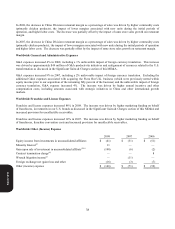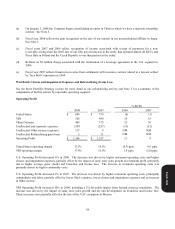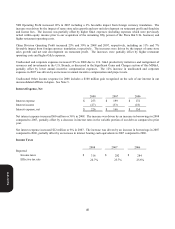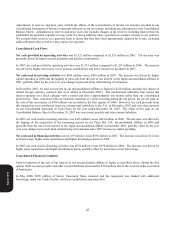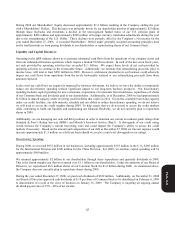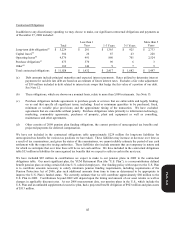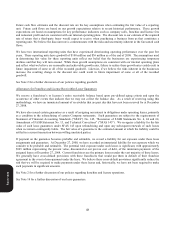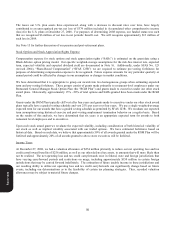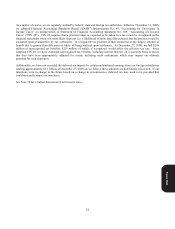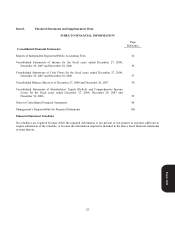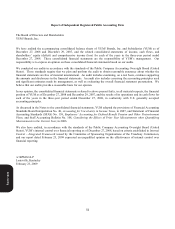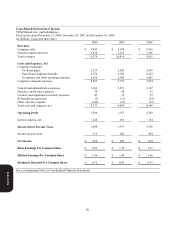Pizza Hut 2008 Annual Report Download - page 169
Download and view the complete annual report
Please find page 169 of the 2008 Pizza Hut annual report below. You can navigate through the pages in the report by either clicking on the pages listed below, or by using the keyword search tool below to find specific information within the annual report.
47
Impairment or Disposal of Long-Lived Assets
We evaluate our restaurant assets and certain definite-lived intangible assets for impairment at the individual restaurant
level except when there is an expectation that we will refranchise restaurants as a group. Impairment evaluations for
individual restaurants that we are currently operating and have not offered for sale are performed on a semi-annual basis
or whenever events or circumstances indicate that the carrying amount of a restaurant may not be recoverable (including a
decision to close a restaurant). Our semi-annual impairment test includes those restaurants that have experienced two
consecutive years of operating losses. Our semi-annual impairment evaluations require an estimation of forecasted cash
flows of the restaurant and any terminal value. We limit assumptions about important factors such as sales growth and
margin improvement to those that are supportable based upon our plans for the unit and actual results at comparable
restaurants.
If the long-lived assets of a restaurant subject to our semi-annual test are not recoverable based upon forecasted,
undiscounted cash flows, we write the assets down to their fair value. This fair value is determined by discounting the
forecasted after tax cash flows, including terminal value, of the restaurant. The discount rate is our estimate of the
required rate of return that a third-party buyer would expect to receive when purchasing a restaurant or groups of
restaurants and its related long-lived assets. The discount rate incorporates observed rates of returns for historical
refranchising market transactions and we believe it is commensurate with the risks and uncertainty inherent in the
forecasted cash flows.
We often refranchise restaurants in groups and, therefore, perform such impairment evaluations at the group level. These
impairment evaluations are generally performed at the date such restaurants are offered for sale. Forecasted cash flows in
such instances consist of estimated holding period cash flows and the expected sales proceeds. Expected sales proceeds
are based on the most relevant of historical sales multiples or bids from buyers, and have historically been reasonably
accurate estimations of the proceeds ultimately received.
We have certain definite-lived intangible assets that are not attributable to a specific restaurant, such as the LJS and A&W
trademark/brand intangible assets and franchise contract rights, which are amortized over their expected useful lives. We
base the expected useful lives of our trademark/brand intangible assets on a number of factors including the competitive
environment, our future development plans for the applicable Concept and the level of franchisee commitment to the
Concept. We generally base the expected useful lives of our franchise contract rights on their respective contractual terms
including renewals when appropriate.
These definite-lived intangible assets are evaluated for impairment whenever events or changes in circumstances indicate
that the carrying amount of the intangible asset may not be recoverable. An intangible asset that is deemed impaired is
written down to its estimated fair value, which is based on discounted cash flows. For purposes of our impairment
analysis, we update the cash flows that were initially used to value the definite-lived intangible asset to reflect our current
estimates and assumptions over the asset’s future remaining life.
See Note 2 for a further discussion of our policy regarding the impairment or disposal of long-lived assets.
Impairment of Goodwill
We evaluate goodwill for impairment on an annual basis or more often if an event occurs or circumstances change that
indicates impairment might exist. Goodwill is evaluated for impairment through the comparison of fair value of our
reporting units to their carrying values. Our reporting units are our operating segments in the U.S. and our business
management units internationally (typically individual countries). Fair value is the price a willing buyer would pay for the
reporting unit, and is generally estimated using either discounted expected future cash flows from operations or the
present value of the estimated future franchise royalty stream plus any estimated sales proceeds from refranchising.
Form 10-K



